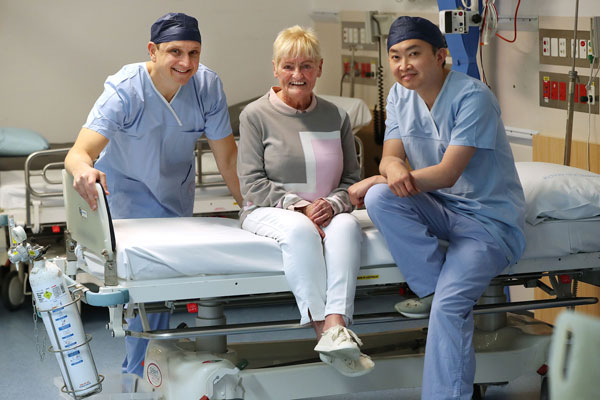
Credit: The Australian Newspaper
Australian Cardiology first gives Nadeane new lease on life
Interventional cardiologist duo Dr Karl Poon and Dr Dale Murdoch had just 10 seconds to save the life of patient Nadeane Giles in a complex Australian-first heart procedure at The Prince Charles Hospital.
Suffering from mitral stenosis – a severe narrowing of her mitral heart valve – 73-year-old Nadeane’s health was ailing as she was left breathless and unable to walk to her letterbox.
All efforts to treat her condition had been rendered unsuitable, with medication exhausted and three surgeons advising open heart surgery was not possible – leaving Nadeane only one option, to take a gamble on a never-before-attempted mitral valve procedure.
Nadeane’s treating team comprising Dr Karl Poon and Dr Dale Murdoch rose to the challenge, spending several months undertaking extensive 3D planning and consulting with colleagues around the globe before tackling the complex procedure in March 2020.
Dr Poon said he had explained to Nadeane the process would be high risk, as her heart would be temporarily stopped while the team remotely placed a new heart valve in the mitral position.
“We were granted just 10 seconds to remotely place the valve in the mitral space within millimetre accuracy while her heart was stopped, however if the valve was incorrectly placed or sized, this would be the difference between life and death,” Dr Poon said.
“This high-risk procedure involves inserting a heart valve through the groin into the middle of the heart without any open chest surgery – the first time in Australia this has been done for the mitral valve position.”
Eight cardiologists and three hours later, Nadeane was out of theatre and immediately experiencing an improvement in her health.
“I knew this procedure was my only chance to live and I was going to take it and run with it,” Ms Giles said.
And run with it she has, returning home to enjoy riding her bike, walking and planning plenty of travel around Australia.
Dr Murdoch said there was an overwhelming sense of relief and excitement when the valve was successfully placed with the aid of expert cardiac imaging performed by TPCH’s Clinical Director Echocardiography Professor Greg Scalia.
Their collective efforts showed results within 30 seconds.
“There was more than 20 of us in the room, and we were so happy to achieve this result for Nadeane, as we could see the heart waking up in front of our eyes,” Dr Murdoch said.
“The success of this procedure now opens doors for dozens of other patients just like Nadeane, who have been unable to be helped so far.”
Dr Poon and Dr Murdoch have been praised internationally by colleagues and peers for their skill and commitment to successfully completing the procedure, but nobody has higher praise for the team than Nadeane.
“I’ll be forever grateful for my second chance,” Ms Giles said.
